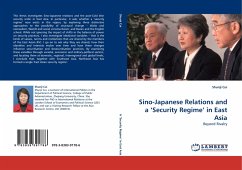Sino-Japanese relations have been on the mend since Shinzo Abe assumed the Prime Minister's office in September 2006. His visit to China in October 2006 and the reciprocal visits of Chinese Prime Minister Wen Jiabao in April 2007, and President Hu Jintao in May 2008, facilitated the further thawing of bilateral relations under the framework of "mutually beneficial relationship based on common strategic relationship." A substantial number of additional events have indicated the continuation of the positive trend in the strengthening of the bilateral relations. However, several issues continue to obstruct the building of long-term confidence between the two Asian giants. Despite the overall improved relations there is very little structural thinking about how to move the Sino-Japanese relations to the next level and how to institutionalize security dialogues at the regional and international level. This book provides an overview of the current situation and also gives suggestions on what is needed to move beyond the haphazard level of cooperation in Northeast Asia, especially as the Six-party talks seem to have broken down. It focuses on Chinese and Japanese perceptions of the bilateral situation, and the potential of, and need for, multilateral structures.








